
The agouti or common agouti is any of several rodent species of the genus Dasyprocta. They are native to Middle America, northern and central South America, and the southern Lesser Antilles. Some species have also been introduced elsewhere in the West Indies. They are related to guinea pigs and look quite similar, but they are larger and have longer legs. The species vary considerably in colour, being brown, reddish, dull orange, greyish, or blackish, but typically with lighter underparts. Their bodies are covered with coarse hair, which is raised when alarmed. They weigh 2.4–6 kg (5.3–13.2 lb) and are 40.5–76 cm (15.9–29.9 in) in length, with short, hairless tails.
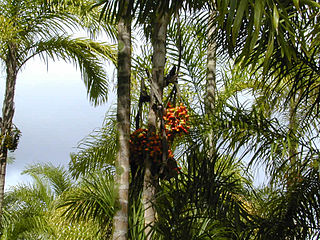
Bactris is a genus of spiny palms which are native to Mexico, South and Central America and the Caribbean. Most species are small trees about 2 m tall, but some are large trees while others are shrubs with subterranean stems. They have simple or pinnately compound leaves and yellow, orange, red or purple-black fruit. The genus is most closely related to several other spiny palms—Acrocomia, Aiphanes, Astrocaryum and Desmoncus. The fruit of several species is edible, most notably B. gasipaes, while others are used medicinally or for construction.

The red-rumped agouti, also known as the golden-rumped agouti, orange-rumped agouti or Brazilian agouti, is a species of agouti from the family Dasyproctidae.
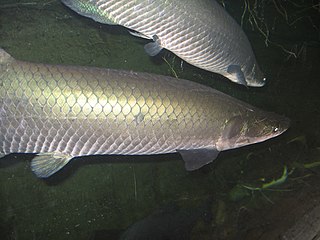
Omagua or low jungle is one of the eight natural regions of Peru. It is located between 80 and 400m above sea level in the Peruvian Amazonia. In this region, there are a lot of rivers that create meanders, swamps and lagoons.
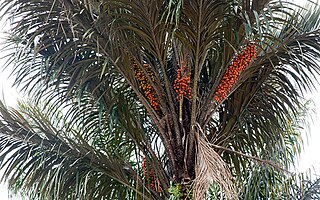
Astrocaryum vulgare is a very spiny palm native to the Guianas and the Amazon. It is species which has greatly benefited from deforestation, as it cannot grow in undisturbed rainforest. In Brazil it is considered typical of Pará state in the north of the lower Amazon. This plant has edible fruit.

Astrocaryum is a genus of about 36 to 40 species of palms native to Central and South America and Trinidad.

Astrocaryum murumuru is a palm native to Amazon Rainforest vegetation in Brazil, which bears edible fruits. Murumuru butter, extracted from the seeds of the plant, may be used as a moisturizer. One remarkable feature of this palm is that it is covered with spines up to twelve inches in length.

Astrocaryum aculeatissimum is a palm native to Atlantic Coast restingas vegetation, which is an ecosystem of Atlantic Forest biome in Brazil. This plant has a commercial value because it has useful fibers which may be used to make production of brooms.

Astrocaryum chambira, the chambira palm or chambira, is a large and spiny palm native to the Amazon Rainforest in Colombia, Ecuador, Peru, and Venezuela that is mostly known for its commercial value as a fiber crop. It can reach over 25 meters in height, and it is not uncommon for climbing trees to be planted nearby to make harvesting the fruit and leaves both easier and safer.
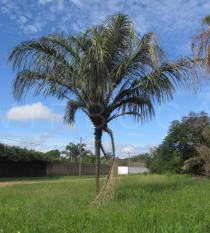
Astrocaryum aculeatum is a palm native to tropical South America and Trinidad. It grows up to 15 m (49 ft) tall and is usually solitary. It has ascending leaves, erect inflorescence, and yellow fruit.
Awara, Awaara or Aawara may refer to:
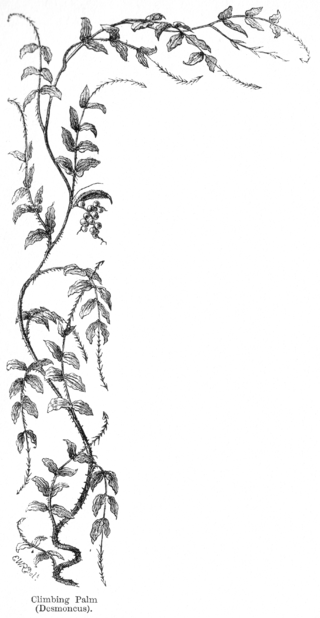
Desmoncus is a genus of mostly climbing, spiny palms native to the Neotropics. The genus extends from Mexico in the north to Brazil and Bolivia in the south, with two species present in the southeastern Caribbean.

Astrocaryum alatum is a species of palm with edible nuts, a flowering plant in the family Arecaceae. It is a common species found many types of rainforests and swamps in Honduras, Costa Rica, Nicaragua and Panama.
Astrocaryum triandrum is a species of flowering plant in the family Arecaceae. It is found only in Colombia. It is threatened by habitat loss.
Astrocaryum urostachys is a species of flowering plant in the family Arecaceae. It is found only in Ecuador. Its natural habitat is subtropical or tropical moist lowland forests.

Bia actorion, the uncertain owlet, bia owl or Actorion owlet, is a species of butterfly of the family Nymphalidae. It is found in the upper Amazon areas of Brazil, Ecuador, Peru and Bolivia.

The Purus várzea (NT0156) is an ecoregion of seasonally flooded várzea forest in the central Amazon basin. It is part of the Amazon biome. The ecoregion is home to a vegetation adapted to floods of up to 12 metres (39 ft) that may last for eight months. There is a great variety of fish and birds, but relatively fewer mammals. Ground-dwelling mammals must migrate to higher ground during the flood season. Threats include logging, cattle farming, over-fishing and mercury pollution from gold mining.

Astrocaryum mexicanum, the chocho palm, cohune palm, or chapay, is a species of cocosoid palm in the family Arecaceae, native to Mexico and Central America. It is very long-lived for a palm, reaching 140 years. Local people harvest its young inflorescences, its seeds, and its hearts for food. Covered with stout spines, it is hardy to USDA zone 10a, and is occasionally planted as an ornamental in places such as Hawaii and Southern California.














